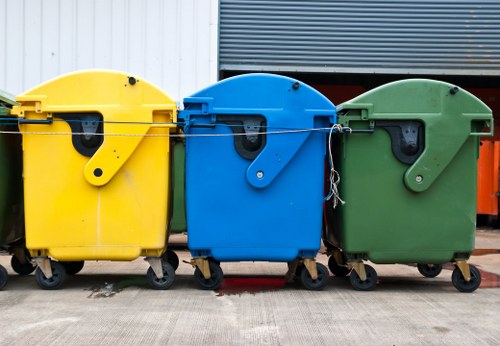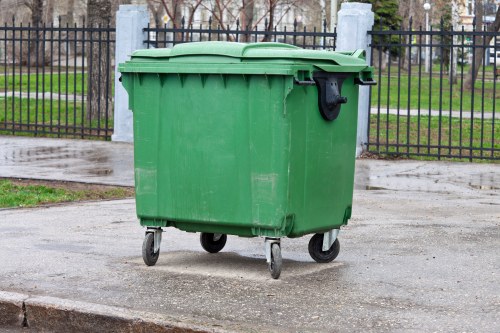Comprehensive Guide to Construction Waste Clearance in Mill Hill

Construction projects, whether large or small, invariably generate waste. Efficient management of this waste is crucial not only for maintaining a clean and safe environment but also for complying with local regulations. In Mill Hill, a bustling area with numerous construction activities, the need for professional construction waste clearance services has never been greater.
Understanding the intricacies of construction waste clearance can help property owners and contractors make informed decisions. This guide delves into the essentials of managing construction waste in Mill Hill, offering insights into best practices, services available, and the benefits of hiring experts for the job.
From the initial stages of project planning to the final cleanup, effective waste management ensures that construction sites remain organized and environmentally responsible.

The Importance of Construction Waste Clearance
Proper construction waste clearance is vital for several reasons. Firstly, it ensures compliance with local regulations, preventing potential fines and legal issues. Secondly, it promotes environmental sustainability by reducing the amount of waste that ends up in landfills. Lastly, maintaining a clean construction site enhances worker safety and overall project efficiency.
In Mill Hill, where urban development is rapid, the volume of construction waste can be substantial. Without effective clearance strategies, this waste can lead to cluttered sites, increased risk of accidents, and negative impacts on the surrounding community.
Implementing a structured waste management plan from the outset of a construction project can mitigate these issues, leading to smoother operations and a positive reputation among clients and neighbors.

Types of Construction Waste
Construction waste encompasses a variety of materials, each requiring specific handling and disposal methods. Common types include:
- Demolition Waste: Materials resulting from the demolition of existing structures, such as concrete, bricks, and metals.
- Excavation Waste: Soil and debris generated from digging and site preparation.
- Packaging Waste: Materials like cardboard, plastic wrapping, and pallets used for transporting construction supplies.
- Hazardous Waste: Substances that require careful disposal, including asbestos, paints, and solvents.
Each type of waste necessitates a tailored approach to ensure safe and efficient clearance. Proper sorting and categorization are fundamental steps in the waste management process.

Benefits of Professional Waste Clearance Services
Hiring professional construction waste clearance services in Mill Hill offers numerous advantages:
- Expertise and Experience: Professionals are trained to handle various types of construction waste, ensuring compliance with all regulations.
- Time and Cost Efficiency: Outsourcing waste clearance allows project teams to focus on core activities, potentially reducing overall project costs.
- Environmental Responsibility: Experts ensure that waste is disposed of responsibly, promoting sustainability and reducing environmental impact.
- Safety: Proper waste management minimizes hazards on the construction site, enhancing the safety of workers and visitors.
By leveraging the expertise of waste clearance professionals, construction projects in Mill Hill can achieve higher standards of efficiency and environmental stewardship.

Steps Involved in Construction Waste Clearance
1. Assessment and Planning
The first step in effective waste clearance is assessing the amount and type of waste generated. This involves surveying the construction site, identifying waste streams, and developing a comprehensive waste management plan.
Key Components:
- Identifying recyclable and non-recyclable materials
- Estimating waste volume
- Scheduling clearance activities
2. Sorting and Segregation
Sorting waste ensures that recyclable materials are separated from non-recyclables. This step is crucial for minimizing landfill usage and promoting recycling initiatives.
Techniques:
- Color-coded bins for different waste types
- On-site sorting facilities
- Training staff on proper segregation methods
3. Collection and Transportation
Once sorted, waste needs to be efficiently collected and transported to appropriate disposal or recycling facilities. Timely transportation prevents site clutter and maintains a safe working environment.
Considerations:
- Choosing reliable transportation services
- Ensuring compliance with transportation regulations
- Scheduling regular pickups to avoid accumulation
4. Recycling and Disposal
Recycling reduces the environmental footprint of construction projects by reusing materials like metal, wood, and concrete. Non-recyclable waste should be disposed of in accordance with local regulations to ensure environmental safety.
Best Practices:
- Partnering with certified recycling facilities
- Implementing zero-waste policies where possible
- Tracking waste disposal methods for accountability
5. Monitoring and Reporting
Continuous monitoring of waste management practices helps in identifying areas for improvement and ensures adherence to environmental standards. Regular reporting provides transparency and facilitates better decision-making.
Tools and Methods:
- Waste tracking software
- Regular site inspections
- Feedback mechanisms for workers
Implementing a robust construction waste clearance system in Mill Hill not only enhances project efficiency but also contributes to a sustainable future.
Regulations and Compliance in Mill Hill
Adhering to local regulations is imperative for construction waste clearance. Mill Hill has specific guidelines that govern waste management practices to ensure environmental protection and public safety.
Key Regulations:
- Waste Disposal Licenses: Contractors must obtain the necessary licenses to dispose of construction waste legally.
- Recycling Requirements: A certain percentage of waste must be recycled or reused, reducing the burden on landfills.
- Hazardous Waste Handling: Specialized procedures are in place for the disposal of hazardous materials to prevent environmental contamination.
Consequences of Non-Compliance:
- Fines and legal penalties
- Project delays due to regulatory interventions
- Damage to company reputation
Staying informed about and compliant with these regulations is essential for smooth project execution and maintaining good standing within the community.
Choosing the Right Waste Clearance Service in Mill Hill
Selecting a reliable construction waste clearance service can significantly impact the success of a construction project. Here are factors to consider when making your choice:
Experience and Expertise
Opt for companies with a proven track record in handling construction waste. Experienced providers are better equipped to manage different types of waste efficiently and compliantly.
Certifications and Licenses:
- Ensure the service is licensed for waste disposal in Mill Hill
- Look for certifications related to environmental management
Comprehensive Services
A full-service waste clearance provider can handle everything from waste assessment and sorting to transportation and recycling. This one-stop approach simplifies project management and ensures consistency in waste handling.
Additional Offerings:
- Emergency clearance services
- Sustainable waste management solutions
- Customized waste plans tailored to project needs
Customer Reviews and Reputation
Research customer feedback and testimonials to gauge the reliability and quality of the service. A company with positive reviews is more likely to deliver satisfactory results.
Where to Look:
- Online review platforms
- Industry forums
- Word-of-mouth recommendations
Investing time in selecting the right waste clearance partner ensures efficient, compliant, and environmentally friendly project outcomes in Mill Hill.
Innovative Solutions in Construction Waste Clearance
The construction industry is increasingly adopting innovative solutions to enhance waste clearance practices. Embracing these advancements can lead to more efficient and sustainable projects.
Automation and Technology
Modern waste management systems leverage technology to streamline processes. Tools like waste tracking software and automated sorting systems improve accuracy and reduce manual labor.
Benefits:
- Real-time monitoring of waste levels
- Data-driven decision-making
- Improved sorting accuracy and efficiency
Green Building Practices
Incorporating green building principles minimizes waste generation from the onset. Strategies include using sustainable materials, designing for disassembly, and implementing waste reduction techniques during construction.
Examples:
- Modular construction methods
- Prefabricated components
- Efficient resource planning
Recycling and Upcycling
Recycling not only reduces the volume of waste but also conserves natural resources. Upcycling transforms waste materials into valuable products, contributing to a circular economy.
Initiatives:
- Partnering with recycling facilities
- Creating upcycled products from construction waste
- Promoting community recycling programs
Integrating these innovative approaches into construction waste clearance processes enhances sustainability and operational efficiency in Mill Hill projects.
Environmental Impact of Effective Waste Management
Effective construction waste management plays a significant role in mitigating environmental impact. Proper clearance and disposal reduce pollution, conserve resources, and promote ecosystem health.
Reducing Landfill Usage
By diverting waste from landfills through recycling and reuse, the strain on these sites is minimized. This extends the lifespan of existing landfills and reduces the need for new ones.
Strategies:
- Maximizing recycling rates
- Implementing waste reduction plans
- Encouraging material reuse on-site
Lowering Carbon Footprint
Recycling and efficient waste management contribute to lowering the carbon footprint of construction projects. Reducing the need for raw material extraction and processing saves energy and reduces greenhouse gas emissions.
Impact Areas:
- Transportation emissions from waste hauling
- Energy consumption in recycling processes
- Emissions from landfill decomposition
Protecting Natural Resources
Recycling construction materials conserves natural resources, ensuring their availability for future generations. It also reduces the environmental degradation associated with raw material extraction.
Conservation Efforts:
- Using recycled materials in new construction
- Promoting sustainable material sourcing
- Educating stakeholders on resource conservation
By prioritizing effective waste management, construction projects in Mill Hill can significantly contribute to environmental preservation and sustainability.
Cost-Effective Waste Clearance Solutions
Implementing efficient waste clearance strategies can lead to substantial cost savings for construction projects. By minimizing waste and optimizing disposal methods, projects can stay within budget and reduce unnecessary expenses.
Minimizing Waste Generation
Reducing the amount of waste produced during construction directly impacts disposal costs. Techniques such as precise material ordering, efficient cutting practices, and design optimization help in minimizing excess waste.
Practical Tips:
- Accurate project planning and material estimation
- Implementing waste reduction protocols
- Training workers on waste minimization techniques
Optimizing Disposal Methods
Choosing the most cost-effective disposal methods enhances overall project efficiency. Recycling materials can be more economical than landfill disposal, especially when partnering with local recycling facilities.
Cost-Saving Strategies:
- Negotiating bulk disposal rates
- Utilizing on-site sorting to reduce transportation costs
- Exploring government incentives for recycling initiatives
Investing in Reusable Materials
Using materials that can be reused in multiple projects reduces the need for purchasing new supplies, leading to long-term cost savings.
Examples:
- Modular construction components
- Recyclable packaging
- Durable building materials
By adopting these cost-effective waste clearance solutions, construction projects in Mill Hill can achieve financial efficiency while maintaining high standards of waste management.
The Future of Construction Waste Clearance in Mill Hill
The construction industry is evolving, with increasing emphasis on sustainable practices and technological advancements. The future of construction waste clearance in Mill Hill looks promising, driven by innovation and a commitment to environmental responsibility.
Embracing Circular Economy Principles
The circular economy model focuses on designing out waste and keeping materials in use for as long as possible. In construction, this means designing buildings with disassembly in mind, using recyclable materials, and promoting the reuse of components.
Implementation Strategies:
- Designing for adaptability and flexibility
- Utilizing modular construction techniques
- Establishing take-back programs for construction materials
Advancements in Recycling Technology
Innovations in recycling technology are making it easier and more efficient to process construction waste. Improved sorting systems, automated processing, and new recycling methods enhance the viability of recycling various materials.
Key Developments:
- Advanced material sorting technologies
- Innovative recycling processes for complex materials
- Integration of digital tools for waste management
Government and Industry Initiatives
Supportive policies and industry collaborations are essential for advancing construction waste clearance practices. Government incentives, regulations, and partnerships with industry stakeholders drive progress toward more sustainable waste management solutions.
Examples:
- Grants for sustainable construction projects
- Regulatory frameworks promoting recycling
- Industry-wide sustainability targets
As these trends continue to develop, construction waste clearance in Mill Hill will become more efficient, sustainable, and integral to the overall success of construction projects.
Conclusion: The Path Forward
Effective construction waste clearance is a critical component of successful construction projects in Mill Hill. It ensures regulatory compliance, promotes environmental sustainability, enhances site safety, and contributes to overall project efficiency.
By partnering with professional waste clearance services, adopting innovative waste management practices, and staying informed about local regulations, construction stakeholders can navigate the complexities of waste management with ease.
Embracing sustainable and cost-effective waste clearance solutions not only benefits individual projects but also promotes a healthier and more sustainable community in Mill Hill.
Contact us today to learn more about our construction waste clearance services and how we can assist you in achieving your project goals efficiently and responsibly.